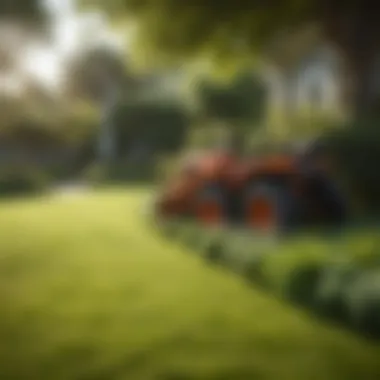Essential Literature for Lawn Maintenance Guide


Intro
Lawn maintenance is an ever-growing field of interest for many people, whether they are homeowners seeking a beautiful green yard or professional landscapers aiming for quality service. Understanding the complexities involved in nurturing grass has become crucial for both groups. With the body of literature available, individuals have a wealth of resources at their fingertips to aid in this endeavor.
This comprehensive guide aims to provide insights into the relevant literature, enriching your knowledge on lawn care, soil management, and environmental sustainability. Each book and guide serves a specific purpose, enabling the reader to cultivate and maintain a thriving lawn.
Overview of the Topic
Definition and Importance
Lawn maintenance encompasses the practice of cultivating, managing, and sustaining healthful grass and plants in outdoor spaces. This yard work is significant not only for aesthetic purposes but also for environmental reasons. Lawns contribute to air quality, biodiversity, and carbon sequestration, playing a vital role in local ecosystems.
In this field, literature serves as a guiding beacon. It helps individuals grasp the essential techniques and practices required for effective lawn upkeep. Understanding the latest scientific research on soil health, pest control, and grass species further empowers individuals to make informed decisions.
Current Trends
The field of lawn maintenance is evolving. Leadings practices now focus heavily on sustainability. Methods that preserve water, promote healthy microbiomes, and utilize native plant species have become increasingly popular. The integration of organic products is growing amid a rising awareness of environmental impact. Similarly, advances in technology, such as drone monitoring and automated irrigation systems, have begun to influence modern lawn care.
As we delve deeper into the essential literature surrounding lawn maintenance, it is vital to consider how these texts embrace current trends and research findings.
Key Techniques and Practices
Step-by-Step Guide
- Understanding Soil Composition
Knowing your soil type is crucial. A well-balanced soil supports grass growth. - Choosing the Right Grass Type
Selection should depend on climate and usage. Kentucky Bluegrass works well in cooler areas, while Bermuda thrives in warmer climates. - Regular Mowing
Maintaining adequate height prevents disease and promotes healthy growth. - Watering Wisely
Deep, infrequent watering encourages root growth. Use early morning for optimal absorption. - Fertilization
Apply fertilizers based on soil tests. Organic options could be beneficial for long-term health.
Tools and Equipment Needed
Several tools enhance lawn care efficiency:
- Lawn Mower
Essential for maintaining the grass at the right height. - Aerator
Helps to improve soil quality by reducing compaction. - Gardening Tools
Such as rakes, spades, and shears for detailed work. - Irrigation System
Automated systems can save time and conserve water.
Challenges and Solutions
Common Obstacles
Maintaining a healthy lawn is not without challenges. Some common issues include:
- Pest Infestation
Pests can undermine grass health and aesthetics. - Weed Growth
Weeds can choke out desirable grass. - Soil Compaction
High foot traffic can lead to poor drainage and reduced growth.
Innovative Solutions
Fortunately, strategies exist to address these challenges:
- Integrated Pest Management (IPM)
Employ techniques that minimize harm to the environment while controlling pests effectively. - Mulching
Organic mulch can suppress weeds and retain moisture in the soil. - Regular Aeration
Aerating the lawn enhances airflow to grassroots, improving overall health.
By focusing on sustainable practices and the latest scientific principles, gardeners and landscapers can cultivate lawns that are not only beautiful but also resilient and environmentally friendly.
This guide provides a starting point toward increased proficiency in lawn maintenance. As exploration of literature continues, deeper insights will emerge, fostering enriched gardening outcomes.
Foreword to Lawn Maintenance Literature
Lawn maintenance literature plays a fundamental role in both cultivating and sustaining an appealing and healthy yard. Understanding the principles found within various texts can greatly enhance the reader's approach to lawn care. Books that focus on this subject encompass a multitude of topics. They cover techniques from soil preparation to pest control, ensuring that lawn owners and landscapers alike have a comprehensive toolset at their disposal.
Importance of Lawn Maintenance Literature
The relevance of literature in lawn care cannot be overstated. First, these resources provide foundational knowledge about essential practices. Homeowners seeking vibrant, healthy lawns can benefit from expert-written guides that demystify the process. Additionally, more seasoned professionals can maximize efficiency by incorporating innovative techniques and insights found in recent publications.
Readers can expect to learn various strategies that address common issues. For example, understanding soil health allows for more informed decisions regarding fertilization and irrigation. This knowledge not only saves time and money but also fosters a more sustainable approach to landscaping.
Incorporating scholarly information alongside practical guides forms a solid educational base. Learning about historical techniques helps gardeners appreciate the evolution of lawn care. Simultaneously, current research provides valuable insights into modern practices. Thus, literature on lawn maintenance creates a bridge connecting traditional wisdom and contemporary methods.
In summary, lawn maintenance literature is crucial for anyone interested in fostering healthy, sustainable outdoor spaces. While it is a resource-rich subject, the underlying benefit remains consistent: knowledge empowers individuals to cultivate impressive lawns and overcome challenges with confidence.
Importance of Knowledge in Lawn Care
Understanding lawn care is not just about aesthetics. It is a complex field that combines elements of botany, soil science, pest management, and environmental awareness. Having a solid foundation of knowledge allows individuals to make informed decisions. This leads to healthier lawns which benefit both the environment and the homeowner's investment.
A key benefit of knowledge in lawn care is efficiency. When gardeners and landscapers are aware of the right techniques and practices, they minimize waste and maximize effectiveness. For example, understanding which grass varieties thrive best in specific climates allows for better selection and less disease. This foresight saves time and resources, reducing the need for constant intervention.
In addition, knowledge helps in pest management. Knowing the life cycles of pests and their natural predators creates a balanced ecosystem in the garden. It allows for the use of organic methods instead of chemical solutions, which can be harmful to the environment. Moreover, educated decisions can lead to fewer symptoms of lawn distress.
Considerations regarding knowledge include recognizing that not all sources are reliable. Enthusiasts and professionals alike should seek reputable books and literature that provide evidence-based practices. Understanding the principles of lawn care from established experts gives a solid ground for implementing techniques in the field.
Knowledge also fosters a sense of community among lawn care enthusiasts. Engaging in discussions regarding best practices or sustainability can be enlightening. Participating in forums such as Reddit provides a platform where experiences and insights can be shared. This interconnectedness encourages continual learning.
"A well-maintained lawn is not merely an ornament; it is a testament to the dedication of its caretaker."
Each individual who invests time in their landscape is contributing to a larger narrative about environmental stewardship.


Historical Context of Lawn Maintenance Books
Understanding the historical context of lawn maintenance literature is essential for both amateur gardeners and professional landscapers. The evolution of these texts reflects societal changes in gardening practices and environmental awareness, making it valuable to explore how these books have shaped contemporary lawn care methodologies.
Early literature on lawn care can be traced back to ancient civilizations, where the aesthetics of green spaces began to gain importance. In historical texts, such as those from Ancient Rome, lawn care was not merely about functionality but also about creating beautiful environments for leisure and social gatherings. This historical view informs today’s lawn maintenance philosophies, emphasizing aesthetics alongside practicality.
In the 19th century, as suburban living expanded, interest in private lawns surged. This shift is fundamentally reflected in literature aimed at homeowners, guiding them on how to cultivate and maintain lush green spaces. Books from this period often introduced the idea of specific grass species suitable for different regions, paving the way for future educational resources. These early works were crucial in establishing a foundation for the common principles of lawn care still used in contemporary practices.
As we moved into the 20th century, the focus on lawn care began to diversify. The increase in research and understanding of soil health led to the publication of books that emphasized the importance of soil preparation. Gradually, authors began to address the interplay between lawns and local ecosystems, marking a period where ecological considerations entered lawn care discussions. This is significant as it showcased a growing awareness of environmental sustainability, which continues to influence modern literature in this field.
Moreover, the late 20th and early 21st centuries saw a boom in lawn maintenance literature reflecting a deeper engagement with sustainable practices. Noteworthy books emerged that highlighted organic lawn care methods, pest management without chemicals, and water conservation techniques. Readers now have access to vast resources that advocate for environmentally-friendly practices, reflecting a shift in priorities among both consumers and writers.
"The history of lawn maintenance literature is not just a narrative of gardening; it recognizes the evolving relationship between humans and nature, guiding us toward more sustainable practices."
Categories of Lawn Maintenance Literature
In the realm of lawn care, literature plays a crucial role. Various categories exist within this vast pool of resources. This section examines three primary categories: DIY guides for homeowners, references for professional landscapers, and ecological practices. Each contributes distinct benefits, insights, and strategies that enhance both basic and advanced lawn care pursuits.
DIY Guides for Homeowners
DIY guides serve as an essential resource for homeowners seeking to maintain their lawns personally. These books often cover foundational topics, such as soil preparation, watering techniques, and seasonal care schedules. They are accessible, engaging, and straightforward, making them ideal for beginners.
A good DIY guide breaks down the processes into manageable steps. For instance, they provide clear instructions on fertilization schedules tailored to specific grass types. The inclusion of visuals can aid comprehension, allowing individuals to connect theory with practice. Furthermore, many guides offer troubleshooting sections to help homeowners identify problems like pests or diseases.
The appeal of these guides is also in their affordability. Homeowners can save considerably by performing their own lawn maintenance. Accessing the right literature can lead to more informed decision-making about tools and resources, leading to better outcomes without incurring high costs.
Professional Landscaper References
For professional landscapers, specialized references take center stage. These books delve deeper into complex topics such as landscape design, advanced pest management, and sustainable practices tailored for commercial operations. They offer insights backed by research, case studies, and best practices from industry experts.
Professional references often include comprehensive data regarding soil types and environmental conditions. They provide detailed analysis on the efficacy of different lawn care products, enabling professionals to make informed choices. This literature often emphasizes the latest technology trends, ensuring that landscapers are equipped with knowledge relevant to current market demands.
Moreover, these references are indispensable during training sessions and workshops. Landscapers use them to develop skills and stay updated on innovations in lawn care. The expertise gained from such literature directly impacts the performance and reputation of landscaping businesses.
Ecological and Sustainable Practices
As the discourse on environmental sustainability grows, ecological lawn care literature gains prominence. These resources educate homeowners and professionals alike about the importance of organic methods and responsible resource management. They cover topics such as low-impact fertilizers, integrated pest management, and water conservation techniques.
Books focused on sustainable practices emphasize the use of native plants and eco-friendly pest control. They encourage the development of lawns that not only fulfill aesthetic desires but also contribute positively to local biodiversity. Understanding ecological principles equips both amateurs and experts with the methods needed to balance beauty and environmental stewardship.
In a market where sustainability is increasingly important, having knowledge of ecological practices can differentiate service providers. Clients are more likely to choose landscapers who prioritize environmentally friendly methods, making this literature a valuable asset.
Ultimately, the categories of lawn maintenance literature cater to varying needs and expertise. By selecting the right type of literature, anyone can enhance their lawn care techniques, making it a more enjoyable and successful endeavor.
Key Topics Covered in Lawn Maintenance Books
The importance of the key topics covered in lawn maintenance books cannot be overstated. These topics form the foundation for understanding how to maintain a healthy and vibrant lawn. Each topic addresses a different aspect of lawn care, providing the necessary knowledge to improve practices and achieve better results.
Understanding soil health, grass selection, fertilization, and pest control are essential for anyone serious about lawn maintenance. This article elaborates on these topics, ensuring that both amateurs and professionals can glean valuable insights.
Soil Preparation and Health
Soil preparation is crucial for lawn success. Healthy soil supports strong grass growth. It provides plants with essential nutrients. The first steps of lawn care involve testing soil pH and making adjustments. This may involve adding lime to raise pH or sulfur to lower it.
In addition, improving soil structure is fundamental. Adding organic matter like compost enhances soil aeration and water retention. This leads to roots growing deeper and accessing more nutrients. A well-prepared soil also encourages beneficial microorganisms to thrive, further enriching the ecosystem within the soil.
Grass Selection and Planting Techniques
Selecting the right type of grass is vital. Different grass species have different needs and tolerances. Factors such as climate, sun exposure, and usage will dictate which grass is the best fit for a particular lawn. For example, Kentucky bluegrass is well-suited for cooler climates, while Bermuda grass thrives in warmer areas.
Once the appropriate grass has been chosen, planting techniques come into play. Proper seeding methods, like ensuring even distribution, are critical for optimal growth. Whether one decides to plant seeds or lay sod, understanding the nuances of each method is essential for achieving a lush lawn.
Fertilization and Irrigation Strategies
Fertilization is necessary for sustaining grass health. It promotes growth and helps green up the lawn. Different fertilizers contain varying ratios of nitrogen, phosphorus, and potassium, which are key in promoting healthy growth. Understanding how to read fertilizer labels is important for selecting the right product.
Irrigation strategies also play a role in lawn maintenance. Adequate watering keeps grass hydrated and promotes deeper root growth. Scheduling watering times efficiently can conserve water while ensuring the grass remains healthy. Both overwatering and underwatering can lead to lawn health issues, so finding the right balance is crucial.
Weed and Pest Control Methods
Weeds and pests can threaten the vitality of a lawn. Learning to identify common lawn weeds is the first step in controlling them. Integrated Weed Management (IWM) is a method that provides effective strategies for control, reducing the reliance on chemical herbicides. This approach combines cultural, mechanical, and chemical methods.
Pest management also requires vigilance. Identifying the signs of pest infestations early helps mitigate damage. Options range from biological control methods to targeted pesticide applications based on the pest type. Fostering a healthy lawn can naturally reduce pest issues, creating a more sustainable environment for grass growth.
"Successful lawn maintenance relies on understanding both the technical and ecological aspects of grass care."
In summary, engaging with the core topics of soil health, grass selection, fertilization, and pest control significantly enhances one's lawn care efforts. Armed with this knowledge, gardeners can create thriving, sustainable lawns.


Influential Authors in Lawn Care Literature
The realm of lawn maintenance literature is significantly shaped by various authors whose insights and expertise inform both amateurs and professionals in their lawn care practices. The value of understanding these influential figures cannot be understated. Their works not only reflect the evolution of lawn care knowledge but also provide practical guidance tailored to diverse environments and challenges. Through their writings, they inspire readers to cultivate healthier lawns and adopt sustainable methods.
Established Experts
Established experts typically have years of experience and their works are a vital resource for anyone interested in lawn maintenance. Authors such as Roger Cook, known for his extensive contributions to various gardening and landscaping publications, provide a wealth of practical advice grounded in real-world applications. His book "The Lawn Care Primer" offers detailed insights into grass selection, pest management, and effective maintenance strategies.
Another notable figure is Ellen Zachos. She emphasizes the importance of native plants and how they can wonderfully coexist within traditional turf landscapes. Her work encourages a shift towards ecological consciousness in lawn care, promoting practices that respect local biodiversity.
The influence of these seasoned authors is also reflected in their accessibility to the public. Not only do they write books, but they also engage in seminars, podcasts, and online forums, creating a community where readers can learn and share knowledge. This interaction enriches understanding and fosters a culture of continuous learning in lawn care practices.
Emerging Voices in Horticulture
While established experts lay foundational knowledge, emerging voices bring fresh perspectives and innovative practices to the field of lawn care literature. New authors often challenge the norms by advocating for methods that incorporate technology and sustainability into traditional practices.
For instance, the works of ecological gardener and author Leslie Land highlight sustainable practices that can be seamlessly integrated into everyday lawn care. Her advocacy for organic methods and use of alternative fertilizers resonate particularly well with environmentally conscious homeowners. Emerging authors like her are essential for broadening the horizon of what lawn maintenance can encompass, particularly in urban and suburban settings.
Moreover, platforms like Reddit and Facebook host groups where these emerging voices share their findings and connect with audiences. These interactions provide valuable insights and foster dialogue regarding the latest trends and innovations in horticulture.
"The new generation of writers pushes the boundaries of traditional knowledge, paving the way for innovative practices that align lawn care with environmental stewardship."
In summary, the contributions of influential authors—both established experts and emerging voices—form a crucial part of lawn care literature. Their perspectives, whether rooted in tradition or innovation, provide the necessary tools for both amateurs and professionals to enhance their lawn maintenance practices effectively.
Recommended Lawn Maintenance Books
Recommended lawn maintenance books serve as essential tools for anyone looking to enhance their lawn care practices, whether they are hobbyists or seasoned landscape professionals. By delving into various titles, readers can gain valuable insights that help them make informed decisions about their lawn care strategies. This section highlights the specific elements and benefits associated with comprehensive guides and specialized titles in lawn maintenance literature.
Comprehensive Guides
Comprehensive guides typically offer an all-in-one solution for lawn care enthusiasts. These books cover a broad array of topics, ranging from soil preparation to pest control strategies. The depth of information often includes practical tips, colorful illustrations, and case studies that can aid in understanding complex concepts.
Key Elements of Comprehensive Guides:
- Holistic Approach: These guides usually take a holistic approach, ensuring that every aspect of lawn care is covered.
- User-Friendly: They are often written in a straightforward style, making them accessible for readers of all skill levels.
- Visual Aids: Diagrams and images play a significant role in comprehension.
Benefits of Using Comprehensive Guides:
- Knowledge Expansion: Readers can learn about the latest techniques and best practices.
- Confidence Building: With enhanced knowledge, gardeners can experiment and take risks in their lawn care.
- Resourcefulness: Comprehensive guides often include additional resources for specific issues, such as pest identification and disease management.
Specialized Titles
While comprehensive guides offer a well-rounded view, specialized titles focus on specific areas of lawn care. These books might delve deeply into subjects such as organic gardening, turf management, or ecological landscaping. They are invaluable for those who wish to master selective topics and build expertise.
Key Elements of Specialized Titles:
- Focused Content: These books often concentrate on niche aspects of lawn maintenance, providing deeper insights than general guides.
- Research-Backed Information: Many specialized titles are supported by research studies, making the information reliable and credible.
- Practical Applications: They usually include case studies that illustrate how the theories can be applied in real-life scenarios.
Benefits of Using Specialized Titles:
- Expert Knowledge: These books often feature contributions from industry experts, ensuring high-quality information.
- Elevated Practices: Readers can implement advanced techniques for sustainable and efficient lawn care.
- Targeted Solutions: Specialized titles provide specific answers to unique problems, making them great references.
"Effective lawn care requires not just a green thumb but also informed decision-making rooted in quality literature."
Analyzing Lawn Maintenance Techniques
Analyzing lawn maintenance techniques is a critical aspect of achieving optimal results in both domestic and professional gardening. Understanding these techniques allows gardeners and landscapers to assess and improve their practices. It highlights the necessity to adapt to evolving methodologies that cater to diverse environments and changing climatic conditions. In this section, we will explore different approaches to lawn care, analyzing traditional and modern practices, while also focusing on common mistakes that practitioners may encounter.
Traditional vs. Modern Practices
Traditional lawn maintenance techniques often emphasize manual labor and established practices passed down through generations. Homeowners have relied on simple tools such as rakes and hoes, combined with organic fertilizers derived from natural substances. This approach values the natural cycles within gardens, fostering biodiversity and utilizing ecological principles.
In contrast, modern practices bring scientific research and technological advancements into play. Today’s gardeners benefit from tools like robotic mowers and smart irrigation systems that enhance efficiency and effectiveness in lawn care. Innovations in genetics have led to the development of hybrid grasses that require less water and resist pests better than their predecessors.
"Adapting to both traditional and modern lawn care techniques provides a holistic approach that enhances sustainability and environmental harmony."
Some professionals suggest merging both approaches. For example, one might use advanced soil-testing technology while also applying organic methods of pest control. This combination can lead to more productive and resilient lawns. Knowing when to shift from traditional to modern practices is essential.
Mistakes to Avoid
Even experienced gardeners can fall victim to common mistakes. Here are some pitfalls that should be carefully navigated to ensure a healthy lawn:
- Ignoring Soil Health: Neglecting soil testing can lead to imbalanced nutrient levels, affecting grass growth.
- Overwatering or Underwatering: Understanding your lawn's specific needs is crucial. Too much or too little water can damage roots.
- Choosing the Wrong Grass Type: Selecting a grass variety that is not suited for local climate conditions can result in poor growth or lawn failure.
- Inconsistent Maintenance: Skipping regular lawn care tasks like mowing, aerating, and fertilizing can lead to a lackluster lawn.
Being aware of these mistakes and addressing them proactively will greatly improve the chances of maintaining a lush and healthy lawn. A systematic evaluation of techniques, both traditional and modern, paired with an awareness of common errors, allows for a more informed and effective approach to lawn care.
The Role of Technology in Lawn Care


The integration of technology in lawn care has transformed how individuals manage and maintain their lawns. Today, gardeners and landscapers have access to a range of tools and software that enhance efficiency and effectiveness. Technology provides essential solutions for common challenges faced in lawn maintenance, such as watering, pest control, and overall health monitoring. Understanding the role of technology in lawn care is crucial for optimizing results and fostering sustainable practices.
The benefits of using technology in this field are multifaceted. First, technology can lead to better resource management. For example, smart irrigation systems minimize water wastage by adjusting to weather conditions. This not only promotes conservation but also improves the overall health of the lawn. Additionally, technology can provide real-time data, allowing for informed decisions based on current conditions.
Moreover, technology enhances precision. Accurate assessments of lawn health can be conducted through various devices, including soil sensors and drones. These tools help identify areas needing attention and measuring necessary resources more precisely. Consequently, the application of fertilizers and pesticides can be optimized, reducing environmental impact and improving yard quality.
"Technological advancements in lawn care can significantly reduce labor and increase productivity, creating healthier landscapes with less effort."
In summary, the role of technology in lawn care is pivotal. It encourages efficient practices and embodies the future of sustainable lawn management. Effective adoption of these technologies is essential for anyone looking to succeed in lawn maintenance.
Innovative Tools and Equipment
Recent advancements have brought forth innovative tools and equipment that cater to various aspects of lawn maintenance. Robotic lawn mowers are a prime example. These devices offer autonomous grass cutting, saving time and labor. They are programmable to maintain specific schedules, allowing for a consistently manicured lawn without constant oversight. Furthermore, these mowers often operate quietly and are designed to navigate complex terrains.
Another essential tool is the soil moisture sensor. This technology can be inserted into the ground to measure moisture levels accurately. This data aids in making informed watering decisions, helping gardeners avoid over or under-watering, which is critical for maintaining plant health. Likewise, lawn care companies benefit from such tools by providing detailed reports on specific customer lawns, enhancing service quality.
Software for Lawn Management
On the software side, various applications have emerged to support lawn maintenance. Programs like Yardbook or LawnPro streamline scheduling, invoicing, and customer relationship management for professionals. They allow users to track services, manage client information, and generate invoices, crucial for running a successful landscaping business.
For individual gardeners, applications like My Lawn or Gardenize offer planning and tracking features. Users can document their lawn’s health, record watering schedules, and set reminders for fertilization and pest control. These apps foster better planning and maintenance, empowering individuals to take control of their green spaces.
Sustainable Lawn Care Practices
Sustainable lawn care practices are becoming increasingly essential in the context of modern landscaping and gardening. They focus on maintaining harmony with the environment while achieving a healthy, attractive lawn. This approach minimizes the adverse effects on ecosystems, reduces the need for chemical inputs, and promotes biodiversity. By embracing sustainability, lawn enthusiasts can enhance the resilience of their lawns and mitigate some common environmental challenges.
Organic Lawn Care Methods
Organic lawn care methods prioritize natural inputs and processes to maintain a healthy lawn. This approach significantly reduces the use of synthetic chemicals that may harm the environment and human health.
Some key points include:
- Natural Fertilizers: Options such as compost, well-rotted manure, and fish emulsion can enrich soil without the risks associated with chemical fertilizers.
- Pest Control: Employing beneficial insects, such as ladybugs, to control pest populations can minimize the need for harmful pesticides.
- Soil Amendments: Using organic materials improves soil structure and health. Adding organic matter enhances nutrient holding capacity, which can lead to a more robust lawn.
"Organic practices not only foster a healthier lawn but also contribute positively to the local ecosystem."
Water Conservation Techniques
Water conservation is vital in sustainable lawn care, especially in areas facing drought or water scarcity. Efficient water use protects this essential resource and promotes healthier grass growth.
Key practices include:
- Irrigation Scheduling: Implementing smart irrigation systems that adjust based on weather conditions can significantly reduce water waste.
- Drought-Tolerant Grass: Selecting grass species that require less water, such as Zoysia or Bermuda, allows for a lush lawn with minimal irrigation.
- Mulching: Using organic mulch can help retain moisture in the soil, reducing the need for frequent watering.
Native Plant Integration
Integrating native plants into lawn designs is a highly sustainable practice. Native plants are adapted to the local climate and soil conditions, which makes them more resilient and easier to maintain.
Some important benefits include:
- Biodiversity: Many native plants support local wildlife, including pollinators, which enhances the overall health of the ecosystem.
- Lower Maintenance: Native plants typically require less water and fewer chemical treatments, which can save time and resources for homeowners.
- Soil Health: Native vegetation promotes a healthy soil ecosystem, improving its structure and nutrient availability over time.
The Ends and Future Directions
In the exploration of lawn maintenance literature, we observe the significant role it plays in both shaping practices and informing future trends. The conclusions drawn from existing resources reflect a combination of traditional wisdom and modern advancements in horticulture. Readers can benefit immensely by not just understanding the content within these texts, but also by applying them to their own gardening and landscaping efforts.
The right literature provides practical insights on maintaining a healthy lawn. It aids in recognizing the importance of soil health, appropriate grass varieties, and sustainable practices. As we look ahead, the integration of technology in lawn care is becoming more prevalent. Books that cover the latest tools and techniques can prepare enthusiasts for these shifts, ensuring they remain competitive and informed.
Benefits of Reflected The Ends
- Knowledge Retention: By studying various texts, individuals will solidify their understanding of essential lawn care principles.
- Trend Awareness: Being aware of new sustainable practices keeps gardeners aligned with environmental needs. This aligns well with increasingly eco-conscious consumer behaviors.
- Adaptive Strategies: Understanding both past and contemporary methods enables lawn caretakers to adapt their strategies effectively.
Considerations for Future Directions
As we consider the future of lawn maintenance, several elements come to the forefront:
- Emphasis on Sustainability: There is a growing need to advocate for ecological methods to balance aesthetics with environmental health. This can lead to more comprehensive literature that focuses on organic practices.
- Evolving Technologies: With emerging software and automation tools, literature will need to address how these methodologies can be incorporated into daily lawn care tasks. As we move forward, the shift towards digital resources may redefine how knowledge is disseminated.
- Inclusion of Diverse Perspectives: Future resources should reflect various cultures and practices in gardening, expanding the dialogue around lawn maintenance and playing a significant role in developing global insights.
Literature related to lawn care not only informs but also inspires new generations of enthusiasts and professionals, contributing to healthier living environments.
In summary, examining conclusions and future directions in lawn maintenance literature prepares both amateurs and professionals for a landscape that is as much about sustainability as it is about aesthetic appeal. By engaging with thoughtful content, readers can ensure their practices are both effective and responsible, fostering lawns that thrive for generations to come.
Final Thoughts on Lawn Maintenance Literature
The literature on lawn maintenance holds significance for both novices and experts in the field. Understanding the various resources enhances the ability to cultivate healthy and robust lawns. Through comprehensive reading, individuals can integrate knowledge about soil health, grass selection, and pest management, thereby improving practical skills.
By exploring essential books and guides, one can gain insights into effective techniques and current methodologies. As demonstrated throughout this article, literature serves as a foundation for successful lawn care practices. It provides critical information on sustainability, technological advancements, and best practices.
In addition, books on lawn maintenance allow individuals to tailor their approach based on specific conditions and needs. For instance, an ecological guide may focus on native plants, while a DIY guide aids in understanding practical steps for homeowners. Such diversity in literature highlights the necessity of selecting the right resources based on personal objectives.
Furthermore, engaging with this literature promotes continuous learning in the rapidly evolving field of horticulture. As best practices and technologies develop, keeping abreast of recent findings ensures that one employs the most effective lawn care techniques. This can lead to better resource management and environmental considerations, addressing the universal challenges of lawn maintenance.
"The best advice comes from those who have not only read about lawn care but also practiced it over time."
Ultimately, the true advantage of engaging with lawn maintenance literature lies in its potential for practical application. By synthesizing the wealth of information available in these resources, readers are empowered to create and maintain aesthetically pleasing and environmentally friendly lawns. Therefore, investing time in this literature should not be seen merely as an optional endeavor but rather as a crucial aspect of developing one’s proficiency in lawn care.



